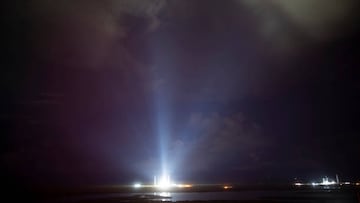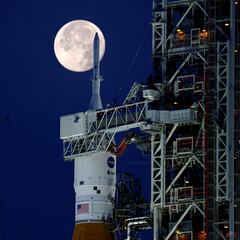What you need to know about NASA’s Artemis I moon mission and launch
The first launch of NASA’s Artemis programme was scheduled to lift off on 29 August, but was delayed due to technical issues at the Kennedy Space Center.


All eyes are on Cape Canaveral as NASA prepares to launch its new generation of lunar missions with Artemis I. The launch will be the first major step in the program, first introduced in 2017, which aims to get humans back on the moon for the first time in 50 years. The new initiative will begin with an unmanned flight that will test the capabilities of the new technology.
WATCH: Artemis 1 is the first stage of missions designed to return astronauts to the moon 🌕, as a part of NASA’s Artemis program. Here is everything you need to know about it https://t.co/A5zcU4qaGL pic.twitter.com/BMHccWqtu2
— Reuters (@Reuters) August 29, 2022
Artemis I will take off from Launch Complex 39B at Kennedy Space Center. The Space Launch System (SLS) rocket is capable of generating some 8.8 million pounds of thrust during liftoff, making it the most powerful NASA rocket to date.
The SLS will carry the Orion module, NASA’s new exploration spacecraft, into orbit before the rocket’s core stage separates from the spacecraft. The SLS’ interim cryogenic propulsion stage will then produce the thrust required to take Orion out of Earth orbit and towards the moon.
Once Orion reaches the moon, it will come to within 62 miles of the lunar surface, before settling into an orbit at an altitude of about 40,000 miles. After six days in lunar orbit, it will begin its journey back to Earth.
When is the launch?
Artemis I was scheduled to lift off from Launch Pad 39B at the Kennedy Space Center in Florida on Monday 29 August, but technical difficulties forced controllers to delay the launch. Operators found a component fuel leak on the launch pad and decided that they had no choice but to postpone the long-awaited event.
Read more: Why was the NASA Artemis I moon launch cancelled?
How can the launch be watched?
Despite Monday’s setback, the launch will still be broadcast by NASA Television, the NASA app, and the agency’s website, nasa.gov once the mechanical concerns have been assuaged.
Coverage will also be available on the agency’s Facebook, Twitch and NASA YouTube channel, as well as in 4k on NASA’s UHD channel.
We are ready. 🚀
— NASA Artemis (@NASAArtemis) August 24, 2022
In just five days, the first launch opportunity of the integrated @NASA_SLS rocket and @NASA_Orion spacecraft will take place. The uncrewed #Artemis I mission around the Moon will pave the way for future crewed missions and begin a new chapter of exploration. pic.twitter.com/fT1tMiGjeb
We will also be hosting a live feed event right here on AS USA, bringing you all the latest information from from the Kennedy Space Center, Cape Canaveral.
When will humans be back on the moon?
Related stories
Artemis’ initial aim was to land humans on the moon in 2024, but NASA Administrator Bill Nelson admitted last November that this objective will not be met.
“2024 was not a goal that was really technically feasible,” Nelson told reporters. “We are estimating no earlier than 2025.”

